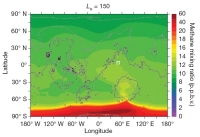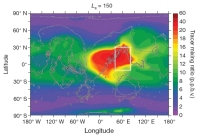Reconciling methane variations on Mars
6 August 2009
Since the discovery of its presence in the Martian atmosphere, methane has remained an intriguing atmospheric component which source (either of biotic or abiotic origin) is not yet fully understood. The recently reported variations in the concentration of atmospheric methane have proven difficult to explain with 3-D numerical models of the atmosphere that include the known chemical and physical processes. In a paper published this week in Nature, Franck Lefèvre and François Forget present their study to derive the implications of the observed methane concentrations on Mars and their variability. They conclude that there needs to be both an intense localised source of methane and a destruction mechanism that is much more efficient than the known atmospheric processes that break down methane. Further, if this efficient destruction of methane occurs only close to the surface, these findings imply a very harsh environment for organic molecules to survive on the surface of Mars.
 |
|
Hubble Space Telescope image of Mars. |
Varying methane concentrations
More extensive measurements of the methane concentrations have confirmed that the atmospheric methane is not uniformly distributed and revealed local enhancements that also varied with the seasons on Mars (Mumma et al. 2009). This is unexpected, because the current understanding of photochemistry in the Martian atmosphere implies an atmospheric lifetime for methane of more than 300 Earth years, which is long enough for smoothing out any local enhancements by circulation resulting in a global uniform distribution.
Observations require shorter atmospheric lifetime
Lefèvre and Forget use a 3-D global dynamical model of the Martian atmosphere that takes into account the currently known atmospheric (photo-)chemical and physical processes, to study the evolution of the atmospheric methane. With this model the only variation in methane concentrations that they initially find is the known global variation caused by the condensation-sublimation cycle of CO2 - when CO2 is extracted from the atmosphere by condensation at the South Pole during southern winter other atmospheric components are effectively enhanced, including methane.
To try and reproduce the recently observed local enhancement and seasonal variation of methane levels, the authors introduce a local and temporary source of methane at the position of a reported maximum (in Syrtis Major, around 10°N, 50°E). The source is defined to be active for 60 Martian days of the Martian year, during the late northern summer. The total amount of methane that is emitted by the source is limited to match the amount removed from the atmosphere in one Martian year. This depends directly on the atmospheric lifetime of methane. In the consensus model the lifetime is defined by the photochemical reactions in the atmosphere and is over 300 years. Under these conditions, the source was found to be not strong enough to produce any detectable local enhancement of methane (Figure 1).
The authors next ran a set of simulations with varying values for the atmospheric lifetime of methane, differing from the consensus. The total amount of methane produced by the local source was kept equal to the loss in a Martian year determined by the selected lifetime. A shorter lifetime means methane is destroyed faster and therefore requires a stronger source to compensate. Three types of sources were compared: a continuous source and a periodic source that was active for either 60 or 120 Martian days of a Martian year.
The combination of a decrease in the atmospheric lifetime for methane by a factor of ~600 (from >300 Earth years to about 200 Earth days), plus a periodic source 600 times stronger than the one in the consensus model is required to reproduce local enhancement at the reported level in the Syrtis Major region (Figure 2).
Short lifetime implies effective sink
The much shorter lifetime implies a very efficient methane destruction mechanism. No currently known atmospheric process that removes methane from the atmosphere is efficient enough to act as a sink with the needed capacity, without leading to conflict with observed values of other atmospheric components. An as yet unidentified process is required. A possibility that the authors discuss is a mechanism in which methane is oxidized at the interface with the Martian soil. Because in this process methane is only destroyed from a limited volume close to the surface the destruction rate, however, needs to be even higher. The derived surface lifetime for methane would be on the order of just 1 hour. If confirmed, this would make the Martian surface an extremely harsh environment for organics to survive.
For a further discussion of this topic in the broader context of the debate around methane on Mars see also the related story "Mars, methane and mysteries", linked from the right-hand menu.
Reference publication
F. Lefèvre & F. Forget, "Observed variations of methane on Mars unexplained by known atmospheric chemistry and physics", Nature, 460, 7256, pp. 720-723, 2009, doi:10.1038/nature08228
Related publications
Formisano, V. et al, "Detection of Methane in the Atmosphere of Mars", Science, Volume 306, Issue 5702, pp. 1758-1761, 2004, doi:10.1126/science.1101732
Krasnopolsky, V.A. et al., "Detection of methane in the martian atmosphere: evidence for life?", Icarus, Volume 172, Issue 2, pp. 537-547, 2004, doi:10.1016/j.icarus.2004.07.004
Mumma, M.J. et al., "Strong Release of Methane on Mars in Northern Summer 2003", Science, Volume 323, Issue 5917, pp. 1041-1045, 2009, doi:10.1126/science.1165243



